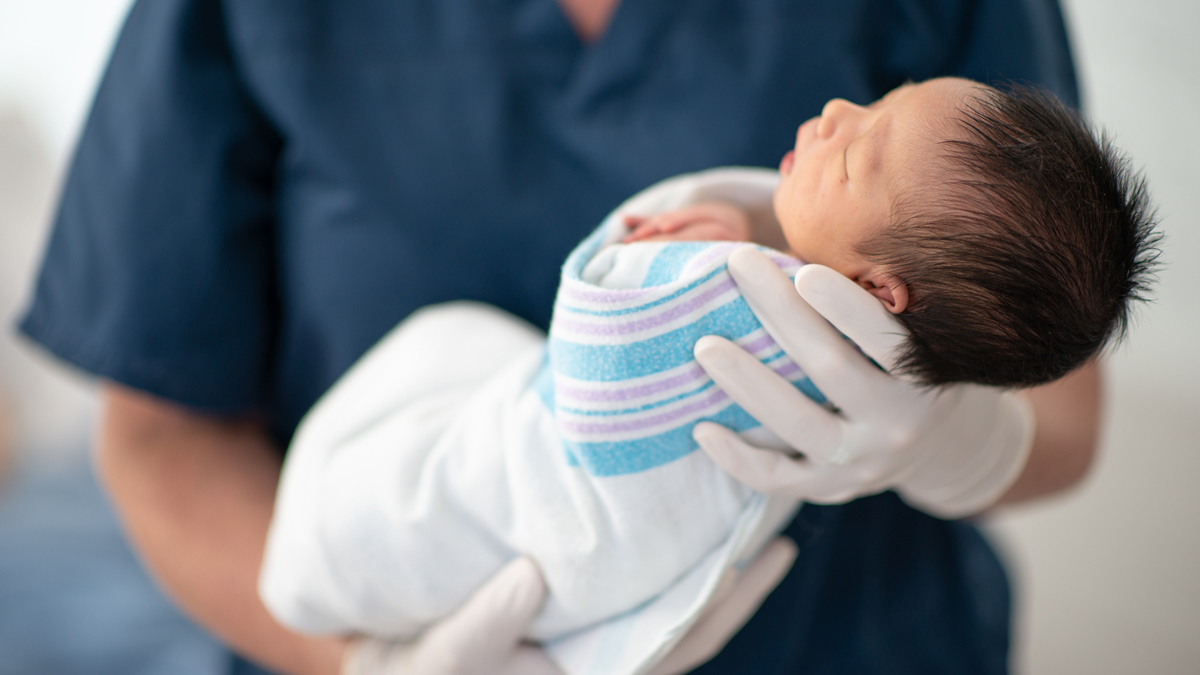What to know
- Vaccination is the best way to prevent hepatitis B virus (HBV) infection.
- Hepatitis B vaccine is safe and effective.
- All pregnant people who are at risk for HBV infection and have not been vaccinated previously should be vaccinated.
- Beginning at birth, all infants should receive the hepatitis B vaccine series.

Composition and dosage
Hepatitis B vaccines are available as a single-antigen formulation and in combination with other vaccines. All hepatitis B vaccines contain yeast protein and aluminum adjuvant.
For pregnant persons, after initial hepatitis B surface antigen (HBsAg) screen is drawn for current pregnancy, initiate vaccine series with Engerix-B, Recombivax-HB, or Twinrix for those who have not previously been vaccinated.
The two single-antigen vaccines, Engerix-B and Recombivax-HB, can be used starting at birth.
Hepatitis B vaccination
Birth dose

All infants should receive a dose of hepatitis B vaccine at birth regardless of the HBV infection status of the birth parent. This birth dose, along with hepatitis B immune globulin (HBIG), serves as postexposure immunoprophylaxis for infants born to a parent with HBV infection.
TABLE 1: Hepatitis B vaccine schedules for infants, by infant birthweight and maternal HBsAg status
| Birthweight | Maternal HBsAg status | Single-antigen vaccine | Single-antigen + combination vaccine | ||
|---|---|---|---|---|---|
| Dose | Age | Dose | Age | ||
| ≥2,000 g | Positive | 1 | Birth (≤12 hrs) | 1 | Birth (≤12 hrs) |
| HBIG§ | Birth (≤12 hrs) | HBIG | Birth (≤12 hrs) | ||
| 2 | 1–2 mos | 2 | 2 mos | ||
| 3 | 6 mos¶ | 3 | 4 mos | ||
| 4 | 6 mos¶ | ||||
| Unknown* | 1 | Birth (≤12 hrs) | 1 | Birth (≤12 hrs) | |
| 2 | 1–2 mos | 2 | 2 mos | ||
| 3 | 6 mos¶ | 3 | 4 mos | ||
| 4 | 6 mos¶ | ||||
| Negative | 1 | Birth (≤24 hrs) | 1 | Birth (≤24 hrs) | |
| 2 | 1–2 mos | 2 | 2 mos | ||
| 3 | 6–18 mos¶ | 3 | 4 mos | ||
| 4 | 6 mos¶ | ||||
| <2,000 g | Positive | 1 | Birth (≤12 hrs) | 1 | Birth (≤12 hrs) |
| HBIG | Birth (≤12 hrs) | HBIG | Birth (≤12 hrs) | ||
| 2 | 1 mos | 2 | 2 mos | ||
| 3 | 2–3 mos | 3 | 4 mos | ||
| 4 | 6 mos¶ | 4 | 6 mos¶ | ||
| Unknown | 1 | Birth (≤12 hrs) | 1 | Birth (≤12 hrs) | |
| HBIG | Birth (≤12 hrs) | HBIG | Birth (≤12 hrs) | ||
| 2 | 1 mos | 2 | 2 mos | ||
| 3 | 2–3 mos | 3 | 4 mos | ||
| 4 | 6 mos¶ | 4 | 6 mos¶ | ||
| Negative | 1 | Hospital discharge or age 1 mo | 1 | Hospital discharge or age 1 mo | |
| 2 | 2 mos | 2 | 2 mos | ||
| 3 | 6–18 mos¶ | 3 | 4 mos | ||
| 4 | 6 mos¶ | ||||
See table source1 and definitions of abbreviations Aand asterisks * B†C §D ¶E below.
Vaccine effectiveness
All hepatitis B vaccines are highly effective in preventing HBV infection. Overall, hepatitis B vaccination produces seroprotection in 98% of healthy term infants. For infants with low birth weights, vaccine response can be lower.2 Vaccine response among infants does not vary considerably by maternal HBsAg status or HBIG administration.
As a postexposure immunoprophylaxis measure for infants born to an HBsAg-positive birth parent, hepatitis B vaccine without HBIG is 75% effective at preventing perinatal HBV transmission, but when combined with HBIG, the effectiveness is 94%. 345The birth dose also provides protection to infants at risk from household exposure to HBV.
Safety and precautions
Scientific evidence overwhelmingly supports the safety of hepatitis B vaccines. As a precaution, doctors should determine if the person getting the vaccine has ever experienced an allergic reaction to:
- A previous dose of hepatitis B vaccine.
- Any part of the hepatitis B vaccine.
- Yeast.
People who are moderately or severely ill should wait until they recover before getting a hepatitis B vaccine. However, administering the vaccine to people with minor illnesses, such as a cold, is fine. Learn more about contraindications and precautions.
Because infants with low birth weights have a decreased response to the vaccine, clinicians may need to delay some vaccine doses. If an infant weighs less than 2,000 grams and was born to an HBsAg-negative birth parent, the vaccine dose should occur at the time of hospital discharge or at age 1 month (even if weight is still less than 2,000 grams).
See Table 1: Hepatitis B vaccine schedules for infants, by infant birthweight and maternal HBsAg status above.
Reporting adverse events
The most common adverse events following hepatitis B vaccination are injection site reactions and mild systemic reactions.
Adverse events occurring after administration of any vaccine should be reported to Vaccine Adverse Event Reporting System (VAERS). Reports should be submitted to VAERS online or by mail.
VAERS is an early warning system, co-managed by CDC and the US Food and Drug Administration (FDA), that monitors potential vaccine safety problems. Doctors and vaccine manufacturers are required by law to report certain adverse events following vaccination to VAERS. Patients and caregivers can also submit reports.
Administration
Clinicians should administer the vaccine to infants intramuscularly into the anterolateral aspect of the thigh. When administering multiple vaccines, clinicians should use different anatomic sites (e.g., separate limbs).
Concurrent administration of other vaccines
Clinicians can administer hepatitis B vaccine concurrently with other vaccines to children and pregnant people. There is no evidence that coadministration reduces the vaccine response or effectiveness.
For detailed information on hepatitis B vaccine schedules, see immunization schedules for children.
Resources
- Perinatal Hepatitis B Prevention Program | CDC
- This site contains resources for PHBPP staff at the state, local, and territorial levels.
- This site contains resources for PHBPP staff at the state, local, and territorial levels.
- Prevention of Hepatitis B Virus Infection in the United States
- This site contains recommendations from the Advisory Committee on Immunization Practices (ACIP).
- This site contains recommendations from the Advisory Committee on Immunization Practices (ACIP).
- Childhood and Adolescent Immunization Schedules
- This site contains the recommended schedule for vaccinating children.
- This site contains the recommended schedule for vaccinating children.
- Guidelines for Standing Orders in Labor & Delivery & Nursery Units
- This document contains recommendations to prevent transmission of HBV to newborns.
- This document contains recommendations to prevent transmission of HBV to newborns.
Vaccine package inserts
Vaccine Information Statement (VIS)
Vaccine Information Statements (VISs) are information sheets produced by CDC that explain both the benefits and risks of a vaccine. View the VIS for hepatitis B vaccine.
- Abbreviations: HBIG = hepatitis B immune globulin; HBsAg = hepatitis B surface antigen.
- * Pregnant persons should have blood drawn and tested for HBsAg as soon as possible after admission for delivery; if the person is found to be HBsAg-positive, the infant should receive HBIG as soon as possible but no later than age 7 days.
- † Pediarix should not be administered before age 6 weeks.
- § HBIG should be administered at a separate anatomical site from vaccine.
- ¶ The final dose in the vaccine series should not be administered before age 24 weeks (164 days).
- Schillie S, Vellozzi C, Reingold A, et al. Prevention of Hepatitis B Virus Infection in the United States: Recommendations of the Advisory Committee on Immunization Practices. MMWR Recomm Rep 2018;67(No. RR-1):1–31.
- Schillie SF, Murphy TV. Seroprotection after recombinant hepatitis B vaccination among newborn infants: a review. Vaccine 2013;31:2506–16.
- Schillie S, Walker T, Veselsky S, et al. Outcomes of infants born to women infected with hepatitis B. Pediatrics. 2015;135:e1141–7.
- Beasley RP, Hwang LY, Lee GC, et al. Prevention of perinatally transmitted hepatitis B virus infections with hepatitis B immune globulin and hepatitis B vaccine. Lancet 1983;322:1099–102.
- Lee C, Gong Y, Brok J, Boxall EH, Gluud C. Effect of hepatitis B immunisation in newborn infants of mothers positive for hepatitis B surface antigen: systematic review and meta-analysis. BMJ 2006;332:328–36.
